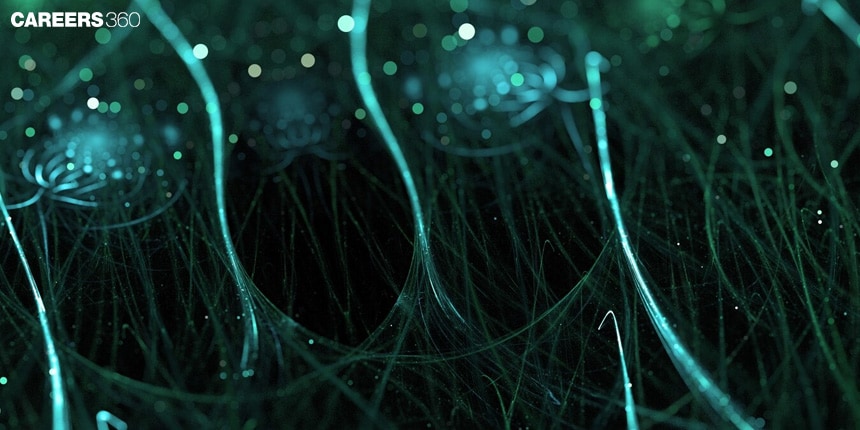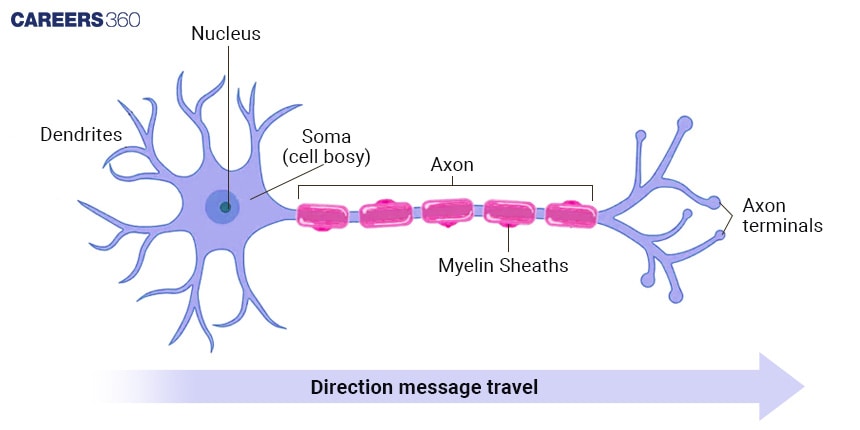Animals Nervous System: Introduction, Classification, Spinal Cord, Neurons
The nervous system is a complex network responsible for coordinating and controlling body activities. It consists of the brain, spinal cord, and nerves, forming the central and peripheral nervous systems. This system processes information from the environment and directs appropriate responses. In this article, nervous system, structure of the nervous system and nervous system parts and functions are discussed. Animal Nervous System is a topic of the chapter Neural Control and Coordination in Biology.
NEET 2025: Mock Test Series | Syllabus | High Scoring Topics | PYQs
NEET Important PYQ's Subject wise: Physics | Chemistry | Biology
New: Meet Careers360 B.Tech/NEET Experts in your City | Book your Seat now
- Nervous System Definition
- Structure of the Nervous System
- Nervous System Parts and Functions

Nervous System Definition
The nervous system is the network of nerves and cells that integrates and transmits action and signals between parts of an animal's body. It is an important part of the organ that serves a principal function in controlling and coordinating body activities, from simple to very complex, sensory perception, and maintaining homeostasis. As such, it enables animals to monitor, adapt, and react to both sets of internal and external stimulations.
Structure of the Nervous System
The broad division of the nervous system is classified into two parts: the Central Nervous System and the Peripheral Nervous System.
Central Nervous System (CNS)
The Central Nervous System consists of two major divisions:
Brain: Structure and Functions
The structure and functions of the cerebrum include higher brain functions such as thought, action, and sensory processing.
The structure and functions of the cerebellum include control over balance, coordination, and fine muscle control.
The structure and functions of the brainstem include regulating vital functions of the body such as heartbeat, breathing, and sleep cycles.
Spinal Cord: Structure and Functions
A cylindrical bundle of nerve fibres extending from the brainstem down the vertebral column.
It transmits information between the brain and the rest of the body and mediates reflex actions.
Peripheral Nervous System (PNS)
The Peripheral Nervous System has the following components:
Somatic Nervous System
It is responsible for controlling voluntary movements and transmitting sensory information towards the CNS.
This comprises nerves connecting to muscles and sensory receptors.
Autonomic Nervous System
Sympathetic Division: This prepares the body for 'fight or flight' responses.
Parasympathetic Division: Serves 'rest and digest' activities.
Neurons: The Functional Units
Neurons are the simplest units of nervous systems that carry nerve impulses.
Types of Neurons
Sensory Neurons: Transmit impulses from sensory receptors to the CNS.
Motor Neurons: Carry instructions from the CNS to muscles and glands.
Interneurons: Integrate neurons within the CNS and interconnect sensory and motor functions.
Structure of Neurons
Cell Body (Soma): Nucleus and organelles.
Dendrite: Receive signals from other neurons.
Axon: Conducts the electrical impulse away from the cell body.
Synapse: Gap between neurons, where neurotransmitters are released.

Neuroglia: The Supporting Cells
- Astrocytes: Provide mechanical support and protection for neurons, and maintain the blood-brain barrier.
- Oligodendrocytes: Generate myelin in the CNS.
- Microglia: Serve as immune cells within the CNS.
- Ependymal Cells: Line ventricles and produce CSF.
Also Read-
- MCQ practice on the Human Nervous System
- Neural Control And Coordination
- Control and Coordination
- Central Nervous System
Nervous System Parts and Functions
The nervous system includes-
Human Brain
Cerebral Cortex: Among its activities are voluntary movement, perception, language, logic, and thought.
Cerebellum: The Cerebellum has a role in preserving posture, mobility, and balance. The cortex envelops each of the two hemispheres that make up the cerebellum.
Hypothalamus: is the area in charge of controlling the body's temperature, hunger, emotions, circadian cycles, and other functions. It functions as a thermostat, detecting body temperature and sending forth signals to regulate it.
Brain stem: also known as the medulla oblongata, is made up of the reticular formation, tectum, tegmentum, pons, and medulla. It regulates blood pressure, breathing, and heart rate.
Thalamus: Through the integration of motor and sensory information, it gathers sensory data and transmits it to the cerebral cortex. It transmits the data it receives from the cerebral cortex to the other parts of the brain and spinal cord.
Limbic system: It consists of the hippocampus, cingulate gyrus, and mammillary bodies, which help control how one reacts to emotions. The hippocampus is essential for learning and memory.
Basal ganglia: The caudate nucleus, globus pallidus, putamen, substantia nigra, and subthalamic nucleus are all part of the basal ganglia, which control movement and balance.
Midbrain: It regulates vision, hearing, eye and body movement. It is made up of inferior and superior colliculi as well as the red nucleus.
Cerebrospinal Nervous System
It is made up of twelve pairs of cranial nerves, each of which has a specific function and is related to the brain. The nerves and their corresponding roles are as follows:
Optic: Sight
Oculomotor: Movement of the eyeball, pupils, and lens
Olfactory: The sense of smell
Trochlear: Eye muscle movement (superior oblique)
Trigeminal: Provides nerves to the cheeks, mouth, eyes, and controls chewing
Abducens: Human lateral rectus muscle action and outward vision
Facial: controls salivary gland function, facial muscle movement, and anterior tongue taste perception
Glossopharyngeal: A gustatory experience
Acoustic: Preserves hearing and balance
Vagus: Provides the organs in the chest and belly with nerve supply
Spinal accessory: Movement of the head and shoulders
Hypoglossal: Controls the tongue's muscles
Types of Nerves
A nerve is created when many axon fibres are bundled together. There are three kinds of nerves:
Sensory
The nerve fibres are referred to as sensory when the impulse travels from the receptor to the brain or spinal cord. The nerves in the ears, eyes, and nerves, for instance.
Motor
A motor neuron is what happens when an impulse travels from the brain or spinal cord to a gland or muscle.
Mixed
Both the motor and sensory nerves are found in a mixed nerve. For instance, the spinal nerves
Parts of the Human Brain
The sense organs send messages to the human brain, which then relays those signals back to the nerves. To shield the brain from mechanical shocks, it is housed inside the skull, which also houses the cerebrospinal fluid. It is separated into three areas:
Forebrain
The receptors send the impulses to it. It contains distinct sections for analysing the various signals, such as smell, hearing, etc. This is also where the thought process occurs. After being analysed, the incoming signals are sent to the appropriate areas.
Midbrain
Numerous voluntary and involuntary processes are carried out by our bodies. Humans are able to manage voluntary movements like pushing and running. Blinking and breathing are examples of involuntary behaviours that are automatic and beyond human control.
Hindbrain
The cerebellum and medulla are located in the hindbrain. These regulate blood, saliva, and respiration.
Also Read-
Frequently Asked Questions (FAQs)
The main function of the nervous system is to sense changes, integrate information, and provoke suitable responses to maintain homeostasis and coordinate activities.
Neurons transmit through electrical signals called action potentials and through a chemical signal in the form of neurotransmitters at synapses.
CNS includes the brain and spinal cord that processes and connects the information. PNS consists of all peripheral nerves that connect the CNS to the rest of the body code.
The reflex action is a rapid, involuntary response to a stimulus having its pathway as the simple reflex arc.
The common ones include Parkinson's characterised by tremors and rigidity; Alzheimer's by amnesia; and Multiple Sclerosis by muscle weakness.
Also Read
30 Nov'24 10:55 AM
29 Nov'24 08:48 PM
29 Nov'24 06:52 PM
29 Nov'24 05:35 PM